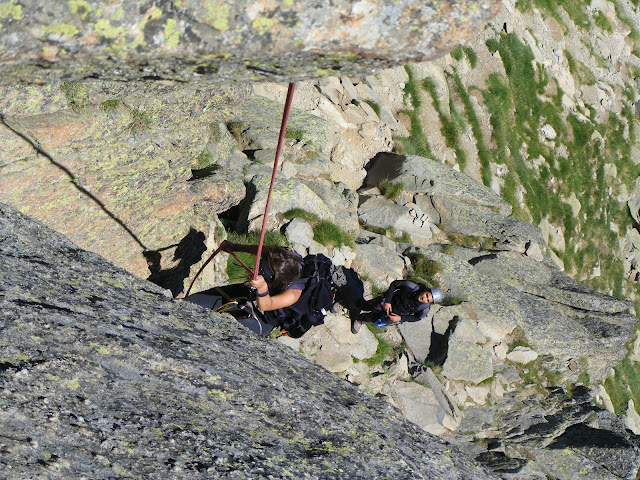Kondairak diño, Gabas(Vallé d'Ossau)-eko artzai batek ardi bet galdu ebela herriti paraje lantzar beten. Harek atzeti segidu eiñ eutson lantzarreti gora. Ardiek gora eta artzaia buru gogor beran atzeti. Ordu betzuk igaro eta gero, Suzon-eko lepora aiega ziran. Antza, lepo hortatik Midi-ra dauen bistaz txoratute, artzaia ardiaz ahaztu ta mendi eder horren gailurrera aiegateko gogoak sartun daken. Esaten deure hori izen zala mendi honetara eiñ zan lelauko igoerea. Mitikoa sekula baino parajeago dauen mendi honetan, edozer gauze posible da.
"euskonews"-etik ataratako argazki
Halan da bere, esan ber da mendi honek dekon bisitari kopurua oso altua dala, masifikaziotik paraje. Kaskoa ezin besteko laguna da mendi hontan, goitik dabiltzesen kordadek bota al datzuten aitzen babesle.
Igoerea bidea oso markatua dago hormara arte. Bertan, paretan hasikeran askori kosta iten dake lelauko tximinia harrapatzea. birriten etor naz mendi hontara eta bi biderrez sartu naz txarto. Argi ibili ber da!
Tximini famatuek ez dake ezelango konplikaziño berezirik. Jakin ber da non gagozen, eta kontu apur betegaz ibilite, ez dau zergatik problemeri egon ber.
Igoereak 3h30'-4h ber dauz Portalet ondoan dauen parkiñeti. handik ordu betera, Pombie-ko aterpea dekogu, beran uzen bariñeko lakuaren parean dauena, mendi paretaren oinarrian.
Midi d'Ossau udabarrian col du Pombietik / Midi on spring from col du Pombie
ENGLISH: This mytical mountain, is one the most espectacular one in the pyrenees. It doesn't reach 3.000 meteres but It's so estetic and incredible. A lot of clinber try climbing it on summer. The summit way is not very technical but requires some knowledge on ropes. At the base of the mountain, there's a refuge close to a lake.
Maybe we're going to describe one of the most popular ascension on pyrenees, but not the easyest one!, we must always carry our helmet with us and at least 30m rope. The ascen from the normal way requires 3h30' from the parking and 2h30' from the refuge.
Midi kokatzen / Where's Midi?
DENBORAK/ Timetable
Parking Cabane d' Arraile - refuge Pombieko aterpea: 1h5' (F)
Refuge du Pombieko aterpea - horma oinarrira/rock base: 50' (F)
Horam oinarritik /Base of the way - Gailurra/Top: 1h45' (F+)
DESKRIZPIOA Description
Portalet-eko muga portutik igaro ostean, kilometro 1 ingergu pasata Frantziko norantzan, eskoietara dekogu parking bet kotxea itziteko. Bertatik urteten da bide gora igoteko. Ordu baten buruan, Pombieko lepora aiegaten gara, bista eleganteak eukinda Midi-taz argazkian ikusten danlez.
From the Portalet mountaing pass, we cross the border on France way and immediately we park the car. From here, we take the trail. O our later, we reach Pombie's hill. (photo)
Ponbieko lakutik Midi d'Ossau. From Pombie lake Midi d'Ossau.
Refuge Pombieko aterpea (1h5', F)
Suzon-eko lepotik, Midi-n gora ein beharreko bidea ikusgai. 500m haitzean, 3 tximini tartean ditugula. Pausurik larriena IIº-koa izango da. From Suzon hill, we can appreciate the way to the summit. 500 metres rock, with 3 vertical steps, wich the most difficult level is around II.
Pareta oinarrian (50min aterpetik/ from the refuge, F+)
1º tximiniko argazkirik ez gendun atara igoera bidean, ez baikenuen harrapatu bide zuzena. Akaberan, bajakeran dau argazki bet 1º tximiniarena.Hurrengo argazkian, 2º tximinia dekogu ikusgai. We've not photos from the 1º difficult step, because we loose the way on the ascension. on this next photo we can see the 2nd step. 2. tximinia superaten (40min pareta oinarritik, F+) Overcoming 2nd step.
Ingurura begiratuta, sekulako bistak dekoguz: Palas, Balaitous, Arriel, Lurien, Frondellas seen from Midi.
2. tximinia igarota, altuerera irebaziz goazela konturatzen gara. 2nd step overcomed, we're gaining some height.
3. tximiniara aiegaten. Reaching 3rd step.(1h10' Horma oinarritik/rock base, F+)
3. tximinia, 3etatik luzeena. the 3rd step, the longest one.
3. tximiniatik urteten. going out from the 3rd step.
Gitxi falta daku gailurreraino... astun iten daku parte hau. Close from the top, we're tired!
Gailurra: 2.884m (1h45' horma oinarritik / from base of the rock, F+)
3. tximinia rapelatzen, seguramente ez da ber rapelatzea, baie holan kordekaz praktikaten dogu. Doing a rappel on 3rd step. It's not so necessary to mount the rappel, but it's going to help us gfrom the travel to Alps.
1. tximinia rapelatzen. rappel honen ostean, bedarran sartungo gara ostabere, haitza atzean itzite. On the 1st rappel. After going down on this part, we're going to start walking on grass again.
Azkenik, aterperaino, eta handik kotxeraino. bidean, marmota xelebre hau ikusi gendun. Then, from rock to the refuge and then to the car.































































